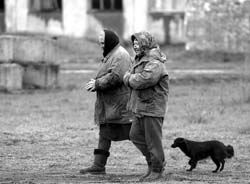No children born in four years
How small villages die
KHMELNYTSKY OBLAST — In the winter of 2001 there were 1,415 villages in this region. Now there is one less village, Vyshneve, which has been “deleted from the registration files.” When a human being dies, it is a tragedy. They say that a small world disappears. What does the disappearance of a populated area from a geographic map signify?
The village of Vyshneve became extinct imperceptibly. What was that lonely old woman, the last resident of the village, thinking during her last moments on this sinful earth? We can only try to imagine how people settled here in the remote 18 th century and started building a village alongside Hrechyntsi, Ivanyntsi, and Mykhunky in Letychiv raion. They built homes, earned their daily bread, and cared about prolonging their family line-forever, or so they thought. But this is how it ended, in contradiction to the logic of life. The village had survived rebellions, revolutions, and wars, but could not survive peacetime.
Gloomy deserted homes, dry wells, and sad trees that have grown wild are the only reminder of what was once a lively place. The villages of Ivanytsi and Mykhunky, and many others, are following in Vyshneve’s footsteps.
In the last five years statisticians have organized a “comprehensive survey of rural populated areas” and observed some trends. Ivanytsi and Mykhunki are listed together with small villages with up to 50 residents. Their number has increased by 27 percent over this period; the number of villages with up to 199 residents, by 11 percent.
In 81 populated areas no children were born in 2001-2004; in 61 there are no residents under five years of age. What can another 171 villages expect with no 15-year-old residents as of last year; 102 villages without 16-year-olds, or 29 villages without residents aged between 18 and 27? Unfortunately, within the next five years they can expect the same tragic lot as Vyshneve.
These forecasts are depressing. The disastrous process of rural decay began when so-called small villages were declared as ones without prospects, and when farms and field camps were destroyed under the slogans of specialization and concentration. This happened under the “unforgettable” collective farm order. Where could people work? Where could they go? Giant socialist industrial projects were built in Khmelnytsky, so they headed there. The urbanization process began. However, in time these enterprises gave up the ghost.
What do we have at this stage of the rural demographic process? After the introduction of “main guidelines” reforms were launched, with the usual inexhaustible enthusiasm. Statistics show disheartening results: “At the beginning of 2005 a total of 169,000 citizens were employed in various spheres, or 51.1 percent of the able-bodied population. Those employed at their places of residence numbered 118,800, of whom 56.8 percent worked in the agrarian sector; 13.6 percent in education; 6.7 percent in health service; 5.6 percent in the industries; the remaining 5.5 percent, in wholesale and retail trade.
A future researcher focusing on the history of rural decay will take this report of Khmelnytsky’s regional statistics department and establish the sad truth: “Mass employment increased and migration in search of better jobs continued. In 2005 the number of rural residents working outside Ukraine increased by seven times.” He will be especially shocked by this information: “In terms of wages and salaries Khmelnytsky oblast ranks last in Ukraine: 266 hryvnias, which is 59 percent of the living wage. By the end of 2005 back wages in rural areas amounted to 35.1 million hryvnias.”
The following statistics are equally depressing: “There are no businesses of any kind in 572 populated areas. In almost one-third of these areas the population exceeds 300 people.” What are these people doing, how are they managing to survive in such conditions? They tirelessly work their kitchen gardens and cattle sheds. Here most of the work is done by low productive and exhausting manual labor. Still, the number of such private plots has dropped to 272,300, a decrease of 6.1 percent in five years and currently amounts to 272,300.
“This is explained by population reductions,” statisticians say. “Compared to the results of the previous survey, only the number of horses and goats has increased, by 25.1 and 0.5 percent respectively, whereas the number of cattle has decreased by 7.8 percent; pigs, by 31.8; and sheep, by 22.1 percent. There is an old folk saying that a goat in a yard is a sign of poverty.
The indefatigable statisticians note that “here and there one sees homes with thatched, reed, and tarpaper roofs.” In springtime the residents say, “When the snow is melting, the roof leaks.” It turns out that “87,200 rural residents have no paved roads in their villages; 33 villages are more than 10 km from such roads.” Incidentally, this is the same distance to the nearest public baths for 1,366 out of 1,415 villages in the region.
Fifty-three villages are 10 km from a medical facility, and the same 10-km distance separates 32 villages from a post office. The number of villages that used to have clubs, libraries, and film projectors has decreased respectively by 9.2, 3.1, and 2.4 percent. In 143 populated areas with 20 and more children approaching school age there are no daycare centers. Since 2001 the network of functioning libraries has decreased by 0.8 percent, medical facilities, by 1.7 percent, and cultural ones, by 10.2 percent.
Does this mean that Vyshneve’s tragic lot will befall its close and distant neighbors?






